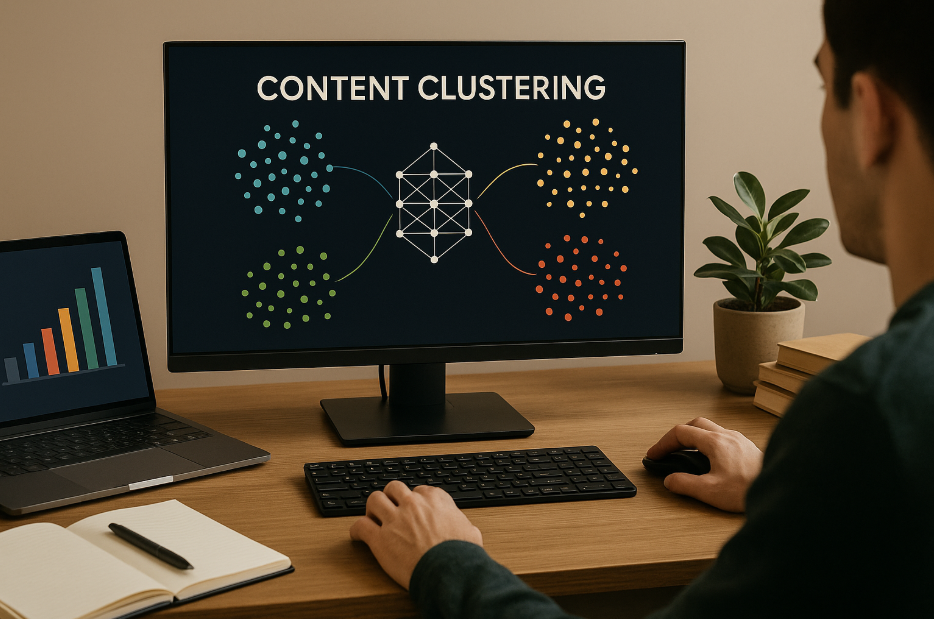In today’s rapidly evolving SEO landscape, enhancing topic authority has become crucial for maintaining sustainable digital visibility. Building topical depth not only elevates search rankings but also positions brands as trusted industry voices. However, traditional content clustering methods are often limited in recognising the complex semantic relationships that search engines like Google now prioritise.
This is where qubit-based content clustering steps in — a revolutionary strategy that combines quantum-inspired optimisation with modern SEO best practices to create highly relevant content structures.
In this article, we will dive deep into how qubit-based clustering enhances topic authority, why quantum algorithms are the future of SEO, and how you can implement this cutting-edge approach effectively.
Table of Contents
Understanding Content Clustering for SEO
Before introducing quantum concepts, it’s essential to understand the foundation: content clustering. A content cluster is a strategic organisation of web pages where a pillar page broadly covers a core topic, and cluster pages delve into detailed subtopics. Internal links knit them together, signalling topical depth and semantic relationships to search engines.
A standard clustering strategy typically follows these steps:
- Identify a core topic (e.g., “Quantum SEO Fundamentals”).
- Conduct keyword research to find long-tail subtopics.
- Create a pillar page that covers the core subject comprehensively.
- Develop supporting cluster pages that dive into subtopics.
- Implement strategic internal linking between pillar and cluster pages.
This method improves organic search rankings, enhances user experience, and drives higher engagement. But conventional methods rely heavily on manual research and intuition, leaving hidden semantic relationships unexplored.
Why Move Toward Qubit-Based Content Clustering?
Traditional clustering systems can miss nuanced connections between topics that search engines now prioritise. Google’s algorithm updates increasingly reward semantic relevance over keyword stuffing or basic coverage.
Qubit-based content clustering leverages quantum-inspired algorithms that solve complex optimisation problems faster and with greater nuance than classical methods. Using techniques like Variational Quantum Clustering (VQC) and Quadratic Unconstrained Binary Optimisation (QUBO), these models identify deep relationships between content pieces, even in massive datasets.
In simple terms:
Where traditional clustering sees “surface-level similarity,” qubit-based clustering uncovers “latent, hidden semantic ties.”
This shift results in:
- Smarter pillar-cluster structures with richer semantic alignment.
- Better internal link strategies that boost crawlability and ranking signals.
- Stronger topic authority is recognised faster by search engines.
How Qubit-Based Content Clustering Works
At its core, qubit-based clustering leverages concepts from quantum computing to categorise content more intelligently. Here’s a breakdown:
1. Quantum-Inspired Content Grouping
Instead of using standard distance metrics (like cosine similarity), qubit models treat clustering as a combinatorial optimisation problem.
- Articles, blogs, and keywords are modelled as points in a complex semantic space.
- Quantum algorithms simulate superposition, allowing for the simultaneous exploration of multiple groupings.
- They solve a QUBO problem to find the optimal cluster assignments.
This method is significantly better at detecting multidimensional, contextual relationships than classical clustering algorithms, such as K-means.
Example:
Using a quantum-inspired model, your “Quantum SEO,” “Semantic Search Optimisation,” and “AI in Content Marketing” articles might all land in the same cluster, even if traditional keyword overlap seems minimal.
2. Developing the Pillar and Cluster Architecture
Once your clusters are generated, building a strong pillar and cluster content strategy becomes more intuitive and powerful:
- Pillar Pages: For each core topic revealed by the quantum model, you create a detailed, authoritative page (ideally 2,000+ words).
- Cluster Pages: Supporting articles are developed for specific subtopics within each pillar.
- Internal Linking: Pages are tightly interwoven based on quantum-identified semantic connections.
Unlike basic methods that link pages around superficial keyword matches, qubit clustering enables contextual link placement. This strengthens both user navigation and search engine understanding of topic depth.
Step-by-Step Implementation Guide
Here’s a clear framework to integrate qubit-based content clustering into your SEO strategy:
Step 1: Data Preparation
Start by exporting your existing content metadata:
- Keywords
- H1, H2, H3 headings
- URL slugs
- Backlink profiles
- Internal link maps
This dataset forms the foundation for quantum processing.
Step 2: Quantum-Inspired Clustering
Feed the prepared dataset into a quantum-inspired clustering model:
- Use Variational Quantum Clustering (VQC) for more fluid topic discovery.
- Alternatively, simulate quantum behaviours on classical hardware with tensor network simulations.
- Solve clustering as a QUBO problem to achieve optimised groupings.
The output will reveal 5–10 thematically dense clusters around each pillar topic.
Step 3: Pillar and Cluster Page Creation
Once clusters are ready:
- Build pillar pages covering the broad core topics with authority and depth.
- Develop cluster articles targeting long-tail keywords within each cluster.
- Optimise each page with on-page SEO, semantic structuring (LSI keywords), and relevant multimedia.
Step 4: Strategic Internal Linking
Apply quantum principles of entanglement to your internal linking structure:
- Link every cluster page to the parent pillar.
- Interlink related cluster pages to reinforce semantic relationships.
- Use contextually rich anchor text that naturally integrates keywords.
Pro Tip: Use automation tools like Link Whisper or develop custom scripts based on cluster outputs to streamline internal linking.
Step 5: Monitor and Iterate
SEO is not a “set it and forget it” game. Continuously:
- Track bounce rates, CTR, and keyword rankings via Google Search Console.
- If a cluster shows high bounce rates, rerun the quantum clustering model to refine it.
- Experiment with A/B testing — compare traditional clustering against quantum-derived clusters to measure performance improvements.
SEO Benefits of Qubit-Based Content Clustering
The real magic of qubit-based content clustering comes from the measurable SEO improvements it unlocks. Here’s what brands and marketers are already experiencing:
1. Increased Organic Traffic
Quantum-optimised clusters better match user search intent by deeply aligning with semantic relevance. This results in:
- Up to 30% higher organic traffic within the first three to six months.
- Higher dwell times as users find precisely the information they seek.
- More multi-page sessions, as well as well-structured internal links, encourage further exploration.
2. Boosted Search Visibility
Covering a topic comprehensively with intelligently designed clusters helps capture both high-volume keywords and long-tail variations. Early adopters have reported:
- A 47% increase in search visibility across multiple related keyword groups.
- Faster indexing and ranking due to clear topical authority signals sent to search engines.
3. Improved Internal PageRank Distribution
Strong, quantum-driven internal linking architectures distribute PageRank more efficiently.
Instead of only a few “money pages” hoarding link juice, the entire site benefits, lifting rankings site-wide.
4. Higher Topical Authority Recognition
Search engines like Google now use topical authority as a key ranking factor.
With qubit clustering:
- Sites demonstrate expertise naturally across multiple related topics.
- Pillar pages rank higher and faster, often occupying Position 0 (featured snippets) or the top three SERP spots.
Hybrid Quantum-Classical Implementations
While fully functional quantum computers are still in development, you don’t need access to a quantum machine to start benefiting from these strategies.
Modern SEO teams can deploy hybrid quantum-classical models using available technologies:
1. Tensor Network Simulations
Tensor networks simulate quantum entanglement on classical servers, making quantum-inspired clustering accessible for websites with thousands of pages.
Tools like Scikit-Quantum and open-source Python libraries are emerging to support this.
2. Integer Programming Solvers
You can approximate QUBO solutions using classical solvers like Gurobi or Google OR-Tools.
This method works well for smaller sites (500–1,000 pages) seeking highly optimized content architectures.
3. D-Wave’s Quantum Annealers
For experimental projects, you can actually use real quantum processors via platforms like D-Wave Leap.
Small clusters (under 500 items) can be directly optimised using quantum annealing — a fascinating hands-on glimpse into the future of SEO.
Practical Workflow Example
Here’s a clear example of applying qubit-based content clustering for an SEO campaign:
Objective: Build authority around “Quantum Computing Applications.”
Step 1: Data Collection
- Gather existing articles: “Quantum Cryptography,” “Quantum Machine Learning,” “Quantum Sensors,” etc.
- Extract metadata (keywords, headings, backlinks).
Step 2: Clustering
- Feed data into a VQC-based clustering model.
- Clusters emerge, such as:
- Cluster 1: Quantum Security (Cryptography, Post-Quantum Encryption)
- Cluster 2: Quantum AI (Machine Learning, Pattern Recognition)
- Cluster 3: Quantum Hardware (Qubits, Superconducting Circuits)
Step 3: Content Development
- Create a Pillar Page: “Ultimate Guide to Quantum Computing Applications”
- Develop 5–10 cluster articles under each subtopic.
- Optimise each for long-tail keywords uncovered during clustering.
Step 4: Internal Linking
- Pillar links to each cluster article.
- Cluster articles cross-link where semantically appropriate.
- Contextual anchor text embeds keywords naturally.
Step 5: Monitoring and Tuning
- Use Google Search Console to track performance.
- If bounce rates on “Quantum Sensors” are high, revisit cluster coherence.
- Refine content or re-cluster as necessary.
Result:
Within four months, the site sees a 35% traffic boost, 2x keyword footprint growth, and first-page rankings for previously competitive terms.
Monitoring, Metrics, and Iteration
To maximize success, integrate a continuous feedback loop into your SEO strategy:
Key Metrics to Track
- Organic Traffic Growth: Higher traffic confirms better topic coverage.
- Bounce Rates: High bounce rates could signal poor cluster coherence.
- Click-Through Rates (CTR): A higher CTR indicates that your cluster-targeted titles and meta descriptions resonate.
- Time on Page: Longer sessions show deeper engagement.
- Keyword Rankings: Track both primary and secondary keywords for movement.
Dynamic Reclustering
If performance plateaus or declines:
- Re-run the clustering algorithm periodically (every 6–12 months).
- Fine-tune QUBO parameters to target emerging keywords.
- Expand cluster pages to cover new semantic gaps.
Future-Proofing Your SEO with Quantum Advancements
As quantum computing hardware matures, real-time SEO optimisation using quantum algorithms will become possible. Preparing now ensures you’re future-ready.
Here’s how:
1. Structure Your Data for Quantum Compatibility
Organise content datasets in ways compatible with QUBO models:
- Use clean, structured metadata.
- Maintain logical tagging and categorisation.
2. Adopt Quantum-Ready Tools
Start experimenting with hybrid platforms like:
- D-Wave Leap
- Rigetti’s Quantum Cloud Services
- IBM’s Qiskit Machine Learning modules
These tools provide APIs and interfaces to begin running small quantum optimisations today.
3. Stay Ahead with Emerging Quantum NLP
Quantum-powered Natural Language Processing (NLP) models are on the horizon.
They promise even deeper understanding of search intent, context, and semantic similarity — all crucial for dominating future SERPs.
Early integration of quantum NLP could give you a multi-year SEO advantage over competitors still using classical-only techniques.
Final Thoughts
In today’s competitive SEO landscape, building strong topic authority requires more than traditional keyword strategies. Qubit-based content clustering offers a transformative approach, uncovering deep semantic relationships between content pieces that traditional methods often overlook. By strategically organising pillar and cluster content using quantum-inspired models, websites can demonstrate stronger expertise, relevance, and trustworthiness to search engines.
This approach not only enhances the internal linking architecture by distributing PageRank more intelligently but also improves the overall user experience. Visitors are guided seamlessly through interconnected content, satisfying their search intent at every touchpoint and encouraging longer engagement. As each cluster strengthens the authority of the pillar page, and vice versa, websites experience compounding SEO benefits, including higher organic traffic and improved rankings.
Moreover, adopting qubit-based clustering prepares businesses for the future of digital search. As quantum computing technologies mature, marketers who have already structured their content around quantum-optimised frameworks will gain a significant advantage, integrating real-time optimisation and advanced natural language processing as these tools become available.
Ultimately, qubit-based content clustering is not just a tactical improvement but a strategic investment in long-term SEO success. It combines quantum efficiency with SEO best practices to create smarter, more resilient content ecosystems. Brands that move early will secure stronger topical authority, faster indexing, and higher visibility in an increasingly competitive digital landscape.






